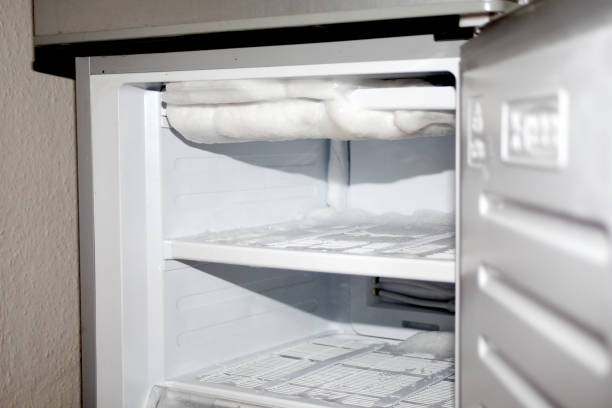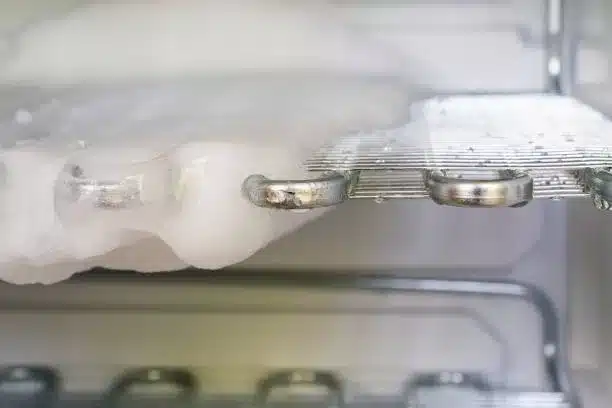A self-defrosting freezer is a freezer that has a feature to prevent frost build-up on the evaporator coil, which cools the air inside the unit. It does this by heating the coil at regular intervals to melt the frost. This feature requires no manual work from the user and makes the freezer easier to clean.
But how does a self-defrosting freezer work, and what are the pros and cons of having one? In this post, we’ll explain the secrets behind self-defrosting freezers and help you decide if they are right for you.
A self-defrosting freezer works by using a defrost timer, a defrost thermostat, and a defrost heater to melt the frost on the evaporator coil. The melted frost drains into a pan and evaporates. A self-defrosting freezer has advantages such as convenience, efficiency, and food quality, but also disadvantages such as higher energy consumption, higher noise level, and potential leakage.
How a Self-Defrosting Freezer Works
A self-defrosting freezer works by using three main components: a defrost timer, a defrost thermostat, and a defrost heater. Here’s how they work together:
- Defrost timer. The defrost timer is an electronic device that controls how often and how long the defrost cycle runs. It usually runs once every 6 to 12 hours for 20 to 30 minutes. During the defrost cycle, the compressor and the fan are turned off and the defrost heater is turned on.
- Defrost thermostat. The defrost thermostat is a sensor that monitors the temperature of the evaporator coil and signals the defrost heater to turn on when it reaches a certain level, usually around 0°C (32°F). It also signals the defrost heater to turn off when it reaches another level, usually around 15°C (59°F). This prevents overheating or underheating of the coil.
- Defrost heater. The defrost heater is an electric element that heats up and melts the frost or ice on the evaporator coil. As the frost or ice melts, water droplets fall from the coil into a drain pan below. The water then flows through a tube to an evaporation tray at the back or bottom of the freezer. The heat from the compressor or condenser coil evaporates the water.

Pros and Cons of a Self-Defrosting Freezer
A self-defrosting freezer has some advantages and disadvantages compared to a manual defrosting freezer. Here are some of them:
Pros
- Convenience. A self-defrosting freezer saves you time and effort by automatically removing frost from your freezer. You don’t have to worry about unplugging your freezer, emptying your food, scraping off ice, or cleaning up water. You also don’t have to worry about frost buildup affecting your freezer performance or food quality.
- Efficiency. A self-defrosting freezer maintains a consistent temperature throughout your freezer and prevents hot spots or cold spots. This helps keep your food frozen and safe for longer. It also prevents excessive frost buildup that can reduce the cooling capacity and airflow of your freezer.
- Food quality. A self-defrosting freezer helps preserve the flavor, texture, color, and nutritional value of your food by preventing freezer burn or ice crystals from forming on your food. Freezer burn or ice crystals can occur when food is exposed to air or moisture in your freezer.
Cons
- Energy consumption. A self-defrosting freezer consumes more energy than a manual defrosting freezer because it has to run an extra heating element during the defrost cycle. This can increase your electricity bill and your carbon footprint.
- Noise level. A self-defrosting freezer can make more noise than a manual defrosting freezer because it has more moving parts and components that can generate sound. You may hear humming, buzzing, clicking, sizzling, or dripping noises from your freezer during normal operation or during the defrost cycle.
- Potential leakage. A self-defrosting freezer can leak water if there is a problem with the drain pan, tube, or tray that collects and evaporates the melted frost. This can cause water damage to your floor or other appliances nearby. You may also notice ice buildup in your drain pan or tube if they are clogged or frozen.

FAQs
Here are some frequently asked questions about self-defrosting freezers:
- How can I tell if my freezer is self-defrosting or manual defrosting? You can tell if your freezer is self-defrosting or manual defrosting by looking at the model number or the user manual of your freezer. You can also look for signs of frost buildup on the walls or shelves of your freezer. If you see frost buildup, you have a manual defrosting freezer. If you don’t see frost buildup, you have a self-defrosting freezer.
- How can I prevent or fix a leaky self-defrosting freezer? You can prevent or fix a leaky self-defrosting freezer by checking and cleaning the drain pan, tube, and tray regularly. You can use a soft brush or a pipe cleaner to remove any dust, dirt, or debris that may clog or freeze the drain system. You can also use a hairdryer, a fan, or a bowl of hot water to melt any ice that may block the drain system.
- Can I manually start or stop the defrost cycle of my self-defrosting freezer? You can manually start or stop the defrost cycle of your self-defrosting freezer by using the defrost timer or button on your freezer. However, this is not recommended unless you are troubleshooting or testing your freezer. Manually starting or stopping the defrost cycle can disrupt the normal operation of your freezer and cause problems such as frost buildup, temperature fluctuations, or spoiled food.
Conclusion
A self-defrosting freezer is a freezer that has a feature to prevent frost buildup on the evaporator coil by heating it at regular intervals to melt the frost. A self-defrosting freezer has advantages such as convenience, efficiency, and food quality, but also disadvantages such as higher energy consumption, higher noise level, and potential leakage.
We hope this post has helped you understand why your freezer is defrosting itself and what are the pros and cons of having a self-defrosting freezer. If you have any questions or need any help with your freezer, feel free to contact us at PressToCook.com. We’re here to help you with all your kitchen appliances and food safety needs.


